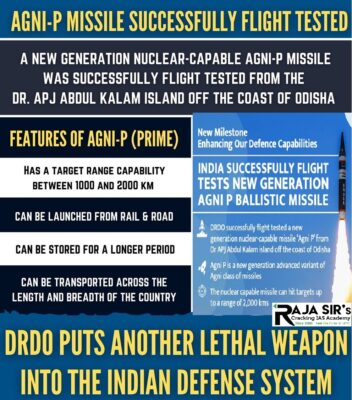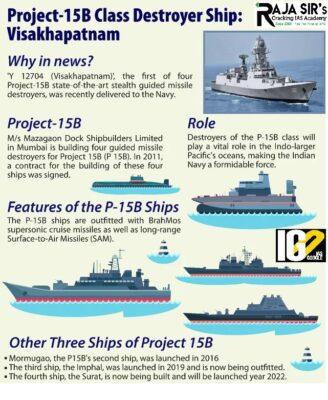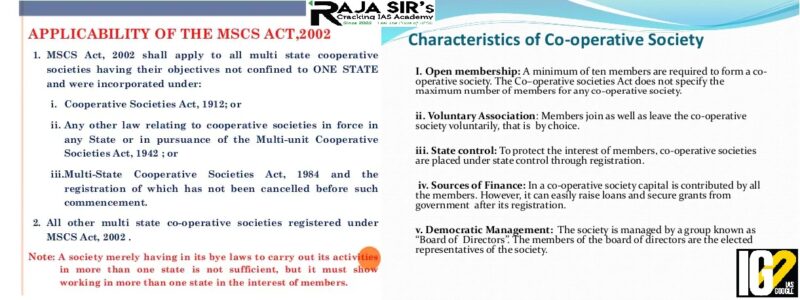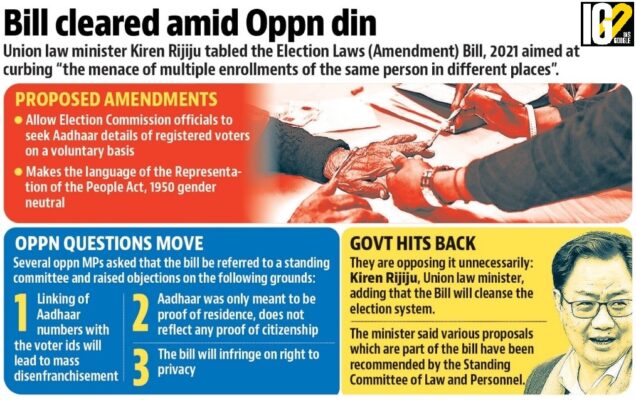- Home
- Prelims
- Mains
- Current Affairs
- Study Materials
- Test Series
 Latest News
Latest News
Dec 20, 2021
DRDO SUCCESSFULLY TESTS NUCLEAR-CAPABLE AGNI PRIME MISSILE
Recently, Defence Research and Development Organisation has successfully tested the new-generation nuclear-capable ballistic missile Agni Prime.
 Agni Prime
Agni Prime

 Amendment in the Minerals (Evidence of Mineral Contents) Rules
Amendment in the Minerals (Evidence of Mineral Contents) Rules
 Cooperative Society:
Cooperative Society:

 It envisages major changes in Section 23 of Representation of the People Act (RPA), 1950, which contains provisions for inclusion of names in electoral rolls.
It envisages major changes in Section 23 of Representation of the People Act (RPA), 1950, which contains provisions for inclusion of names in electoral rolls.
 Agni Prime
Agni Prime
- Type: Medium Range Ballistic Missile
- Range: 1,000-2,000 kilometres
- It is two-stage canisterised solid propellant ballistic missile with dual redundant navigation and guidance system.
- It is the sixth missile in the Agni (missile) series of a ballistic missiles.
- It is capable of covering vital targets all across Pakistan.
- The Agni P weighs 50 percent lesser than the Agni 3 missile and can be launched from rail or road.
- Range: 700 – 1200 kilometres
- Type: Short-Range Ballistic Missile
- Pay Load: 1,000 Kg
- It is an indigenously developed surface-to-surface, single-stage missile that was inducted into service in 2004.
- It is propelled by a solid rocket propellant system.
- Range: 2000-3500 kilometres
- Type: Medium-range ballistic missile
- Pay Load: 820–2,000 Kg
- It is equipped with an advanced high accurate navigation system.
- Range: 3,000–5,000 kilometres
- Type: Intermediate-range ballistic missile
- Pay Load: 2,500 Kg
- It was designed to hold at risk targets in all of Pakistan and much of China from across Indian territory.
- It is a two-stage, solid-propellant missile deployed in rail-mobile mode.
- Range: 3,500 – 4,000 kilometres
- Type: Intermediate-range ballistic missile
- Pay Load: 800–1,000Kg
- It uses a two-stage rocket engine powered by solid propellant.
- It has the most accurate ring laser gyro-based inertial navigation system (RINS) and is supported by a highly reliable redundant micro navigation system (MINGS).
- The Agni-IV ensures the vehicle reaches the target within two-digit accuracy.
- Range: 5,000 – 8,000 kilometres
- Type: Intercontinental ballistic missile
- Pay Load: 1,500 Kg
- It has been developed by the Defence Research and Development Organisation under the Integrated Guided Missile Development Program.
- It made India join the super-exclusive club of countries with ICBMs (missiles with a range of over 5,000-5,500km) alongside the US, Russia, China, France and the UK.
- Agni-V is capable of striking even the northernmost parts of China.
- Range: 11,000–12,000 kilometres
- Type: Intercontinental ballistic missile
- Pay Load: 3,000 Kg
- Currently, it is in the early stages of development.
- It is to be the latest and most advanced version among the Agni missile program.
- It will be capable of being launched from submarines as well as from land.
- INS Mormugao is the second ship of the Visakhapatnam class stealth guided missile destroyers of the Indian Navy.
- It is being constructed at Mazagon Dock Limited (MDL).
- It is named after the port city of Mormugao in Goa.
- It was built under the project P-15B.

- It is class of guided missile destroyers that are an improved variant of the Kolkata-class destroyers.
- It will have:
- State of the art sensor package and weapons.
- Multiple fire zones.
- Battle damage control systems (BDCS).
- Distributional power systems for improved survivability.
- Reliability in emergent conditions.
 Amendment in the Minerals (Evidence of Mineral Contents) Rules
Amendment in the Minerals (Evidence of Mineral Contents) Rules
- This will enable any person, who is intending to participate in auction, to propose suitable blocks for auction for composite license where mineral potentiality of the blocks has been identified based on the available geoscience data.
- A committee constituted by State Government shall assess the mineral potentiality of the blocks so proposed and recommend the block for auction.
- It provides that in case the blocks proposed by any person are notified for auction, that person would be provided incentive of depositing only half of the bid security amount in auction of the blocks proposed by him.
- It will pave the way for sale of 50 per cent of mineral produced from captive mines, transfer of mines without any charges and partial surrender of a lease.
- Aim: Increasing employment and investment in the mining sector, increasing revenues to states, raising the production and time-bound operationalisation of mines.
- The allowance for sale of prescribed quantity of mineral shall also motivate the lessees to enhance the production from the captive mines.
- A mineral is a naturally occurring inorganic element or compound having an orderly internal structure and characteristic chemical composition, crystal form, and physical properties.
- Common minerals include quartz, feldspar, mica, amphibole, olivine, and calcite.
- In India, 11 states account for 90 % of the total number of operational mines (Andhra Pradesh, Orrisa, Chhattisgarh, Jharkhand, West Bengal, Maharashtra, Tamil Nadu, Gujarat, Madhya Pradesh, Rajasthan, and Karnataka).
- According to Mines and Minerals (Development and Regulation) Act, 1957, Minerals are divided as major and minor minerals.
- Major minerals are those which are mentioned under first schedule of MMDR act 1957. Such as coal, lignite etc.
- MMDR Act do not define major minerals.
- Minor minerals are building materials or sand which are notified by central government.
- Major minerals are those which are mentioned under first schedule of MMDR act 1957. Such as coal, lignite etc.
- The CADS-500 is used for precise delivery of payload up to 500 kgs at predetermined location.
- It makes use of maneuverable capabilities of Ram Air Parachute (RAP).
- It uses Global Positioning System for the coordinates, altitude and heading sensors for the heading information during its flight.
- It autonomously steers its flight path using waypoint navigation towards target location by operating controls.
 Cooperative Society:
Cooperative Society:
- It is an autonomous association of persons united voluntarily to meet their common economic, social, and cultural needs and aspirations through a jointly-owned enterprise.
- Cooperatives are democratically owned by their members, with each member having one vote in electing the board of directors.
- Cooperatives are a state subject.
- But there are many societies such as those for sugar and milk, banks, milk unions etc. whose members and areas of operation are spread across more than one state.
- It means a society registered or deemed to be registered under the MSCS Act, 2002 and includes a national co-operative society and a federal co-operative.
- The Act provides for the formation of both the types of cooperative societies viz;
- Primary (with both individual and institutional members)
- Federal Cooperatives (with only institutional membership)
- It is not necessary that a society should have branches in more than one state.
- It may have branches limited to one state and it shall not cease to be a multi-state co-operative society, so long as it serves the interest of members in more than one state.
- Their board of directors has representation from all states they operate in.
- Administrative and financial control of these societies is with the central registrar.
- No state government official can wield any control on them.
- Maharashtra has the highest number of such societies.
- Credit societies constitute the bulk of registered societies followed by agro-based ones (which include sugar mills, spinning mills).
- There are 96 multistate cooperative dairies and 66 multistate cooperative banks.
- The system for state-registered societies includes checks and balances at multiple layers to ensure transparency in the process.
- These layers do not exist in the case of multistate societies.
- Instead, the board of directors has control of all finances and administration.
- There is an apparent lack of day-to-day government control on such societies.
- Multistate cooperatives need not have to submit multiple reports to the state registrar, unlike state cooperatives.
- The central registrar can only allow inspection of the societies under special conditions.
- The on-ground infrastructure for central registrar is thin — there are no officers or offices at state level, with most work being carried out either online or through correspondence.
- Initiated by: Indian Council of Medical Research (ICMR) in collaboration with state health and family welfare (H&FW) department.
- Aim: To deliver COVID-19 vaccines to remote areas and strengthen the vaccine delivery system.
- Aim: To create a statutory framework for tackling doping in sport and give greater powers to the country’s doping watchdog.

- The National Anti-Doping Agency (NADA) will conduct investigation, levying sanctions for Anti-Doping rule violations, disciplinary procedures to be adopted, sample collection and sharing of information.
- NADA will be headed by a Director-General, to be appointed by the central government.
- To implement anti-doping rules and regulate dope control programme.
- To promote education and research and creating awareness about doping and its ill effects.
- To implement the anti-doping code to achieve compliance by all sports organizations in the Country.
- To coordinate dope testing program through all participating stakeholders.
- To promote anti-doping research and education to inculcate the value of dope free sports.
- To adopt best practice standards and quality systems to enable effective implementation and continual improvement of the program.
- The Bill establishes a National Board for Anti-Doping in Sports to make recommendations to the government on anti-doping regulation and compliance of international commitments on anti-doping.
- The Board will oversee the activities of the Agency and issue directions to it.
- It will consist of a chairperson and two members appointed by the central government.
- The Board will constitute a National Anti-Doping Disciplinary Panel for determining consequences of Anti-Doping Rule Violations.
- The Panel will consist of a chairperson and four Vice-Chairpersons and ten members (medical practitioners and retired eminent athletes).
- The Board will also constitute a National Anti-Doping Appeal Panel to hear appeals against:
- Refusal to grant therapeutic use exemption
- Imposition of consequences for anti-doping rule violation
- Any other decision as prescribed.
- A chairperson (a retired High Court judge)
- A Vice-Chairperson (a legal expert)
- Four members (medical practitioners and retired eminent athletes).
- The existing National Dope Testing Laboratory will be deemed to be the principal dope testing laboratory.
- The central government will establish more National Dope Testing Laboratories.
 It envisages major changes in Section 23 of Representation of the People Act (RPA), 1950, which contains provisions for inclusion of names in electoral rolls.
It envisages major changes in Section 23 of Representation of the People Act (RPA), 1950, which contains provisions for inclusion of names in electoral rolls.
- Section 15: For every constituency there shall be an electoral roll, which shall be prepared in accordance with the provisions of this Act under the superintendence, direction and control of the election commission.
- Section 16: A person shall be disqualified for registration in an electoral roll if he is not a citizen of India.
- Sections 17: No person shall be entitled to be registered in the electoral roll for more than one constituency.
- Section 18: No person shall be entitled to be registered in the electoral roll more than once.
- Section 19: Every person who is not less than 18 years of age on the qualifying date and is ordinarily resident in a constituency shall be entitled to be registered in the electoral roll.
- Section 23 is directly related to Sections 15, 17 and 18 of the law.
- The amendment seeks to include new clauses authorizing electoral registration officers to seek the Aadhaar numbers of people who want to register as voters for the purpose of establishing identity.
- No application for inclusion of name in the electoral roll shall be denied and no entries in the electoral roll shall be deleted for inability of an individual to furnish or intimate an Aadhaar number
- The electoral registration officers allow such individuals to produce other documents.
- Even after 18 years, one has to wait a whole year to exercise their voting rights if they couldn't register on Jan 1 (of the year of revision of electoral roll).
- The passage of electoral bill gives 4 qualifying dates a year to register as voters.
- The bill proposes to replace the word "wife" with "spouse".
- An Army man's wife is entitled to be enrolled as a service voter, but a woman Army officer's husband is not.
- The bill empowers the authorities with all the powers required to take over premises for the conduct of elections.
- There are privacy concerns and the possibility of voter manipulation, since large amounts of personal data linked to Aadhaar would now be linked to the Election Commission’s voter database.
- The Election Commission of India started National Electoral Roll Purification and Authentication Programme in March 2015 to link Aadhaar to voter IDs, to delete names in the voter list that had been duplicated.
- The effects of this linkage were seen three years later in the 2018 Assembly elections in Telangana.
- Lakhs of voters found their names to be missing from the voter list.
- 27 lakh voters had been deleted.
- Andhra Pradesh saw a similar decline of around 20 lakh voters, out of a total voter base of 3.71 crore voters.
- In many cases deletions took place without due diligence: there was no proper door-to-door verification of voters whose names were to be deleted.
- Problem of exclusion due to Aadhaar has been flagged previously.
- In 2020, a sample of 213 ration card deletions occurred when Aadhaar was linked to ration cards in Jharkhand in 2016 and 2017, only 12% were legitimate deletions.
- The remaining 88% were found to belong to families that had valid claim to the cards.
- The government’s push has sparked other concerns, given that India does not have a functional data protection law.
- Aadhaar data of 7.8 crore residents from Andhra Pradesh and Telangana got leaked in 2019.
- The data was also linked to the voter database.










 General Studies
General Studies